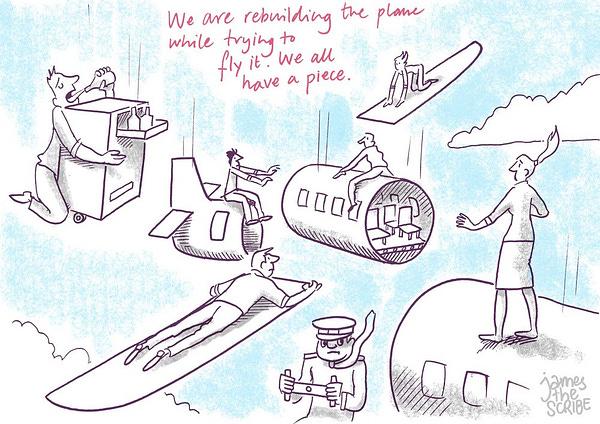‘[…] a highly topical issue in the science community: that of research data management and FAIR data.’
[Peer-Reviewer 1]
A new paper on data management laments that the processes underlying the best practices of research data management were ‘overly focussed on the needs of specific research projects or aligned to a single data repository’. ‘[T]his “silo” approach is hampering [the data’s] general adoption by the broader research community and individual labs.’
To remedy this shortcoming, the authors present a strategy for integration and bridging between the ‘silos’, by mapping the available tools for nanomaterials safety research (including nanomaterials characterisation, nonstandard (mechanistic-focussed) methods, measurement principles and experimental setup, environmental fate and requirements from new research foci such as safe and sustainable by design). In their paper entitled ‘Metadata stewardship in nanosafety research: learning from the past, preparing for an “on-the-fly” FAIR future’, the authors demonstrate how focussing on the needs of data providers and data users helps to identify how existing tools and approaches can be re-framed to enable “on-the-fly” (meta) data definition, data capture, curation and FAIRification, that are sufficiently flexible to address the complexity in nanosafety research, yet harmonised enough to facilitate integration of datasets from different sources generated for different research purposes.

‘The manuscript is well organised, well written and gives new impulses to the field (as a perspective should do). The authors have done a really good job in collecting important services, standards and ontologies for the FAIRification of nanoscience data and setting this into a big picture with recommendations for the future.’
[Peer-Reviewer 2]
A non-linear Approach to FAIRification
To analyse how the existing data management tools can be modified or applied to address both the data generator and data user needs more effectively the resulting ecosystem should reflect the non-linear nature of the scientific process and that the two perspectives are broadly aligned.
‘The field of nanosafety is very complex from the perspective of metadata. This manuscript gives an overview of these complexities, the current state of the art, identifies the main issues, organizes it into two main “hypotheses”, defines needs and possible solutions and ends with a possible roadmap.’
[Peer-Reviewer 1]
- Hypothesis 1 – Existing solutions need to be re-designed to be both generic and customisable in order to address the broadest set of data provider’s needs (the data provider perspective)
- Hypothesis 2 – Existing solutions can be made interoperable through recording of rich metadata and a deeper understanding of the concept of data re-use (the data user perspective)
Meeting Requirements from new Research Foci
The authors note that ‘minimal reporting requirements, (meta)data standards and templates, and input interfaces, have to continuously follow the science and technology to be able to present the state-of-the-art. This needs to be done based on the learnings from previous projects and by adopting and adapting the existing concepts and solutions. Knowledge transfer has to be based on technical solutions allowing extensions and modifications to constantly improve the (meta)data completeness preferable with documentation of the decision process.’
Structured (meta)data input via Web Interfaces
The paper described the use of questionnaires to implement a system where experiments are described as flexible workflows: ‘The (meta)data is then collected for the steps in these workflows using a deeply interlinked web-based system between protocols and data, as the two components of the knowledge warehouse (Figure). […] Previously uploaded similar datasets can be used as guidance by providing the (meta)data structures as well as by being able to reuse parts of the information for scientific equipment, solvents and even complete protocols.’

Beyond Nanosafety
‘[…] we hope that this paper will foster further “change of mindset” to recognise the inherent value of data FAIRification for each individual, each research group, each project and finally for the scientific community more generally.’
[T. E. Exner et al., ‘Metadata stewardship in nanosafety research: learning from the past, preparing for an “on-the-fly” FAIR future’, Front. Phys. 11:1233879, doi: https://doi.org/10.3389/fphy.2023.1233879.]
The authors add that ‘[m]any of the issues discussed above are caused by the intrinsic multidisciplinarity of nanosafety research. This results in many different data types (nanomaterials functionality, physicochemical characterization, human and environmental toxicity, exposure, life-cycle assessment, circularity) as well as methods (in chemico, in vivo, in vitro, ex vivo, in silico) and throughputs each with their specific requirements for data documentation and management. Other disciplines are facing similar issues and interdisciplinary research across natural science, humanities and social science will make sharing and combining data of very different origin inevitable.’
The next steps are to generalise the approach by defining a process to build consensus (meta)data standards, develop solutions to make (meta)data more machine actionable (on the fly ontology development) and establish a distributed FAIR data ecosystem maintained by the community beyond specific projects. Since other multidisciplinary domains might also struggle with data silofication, the learnings presented here may be transferrable to facilitate data sharing within other communities and support harmonization of approaches across disciplines to prepare the ground for cross-domain interoperability.
‘One has to hope that the nano community reads this article and that the article gets out of the FAIR data community.’
[Peer-Reviewer 2]
Follow this link to read the full paper.
To find out more about the lead author, read the recent Partner Spotlight of the MACRAMÉ Project.








